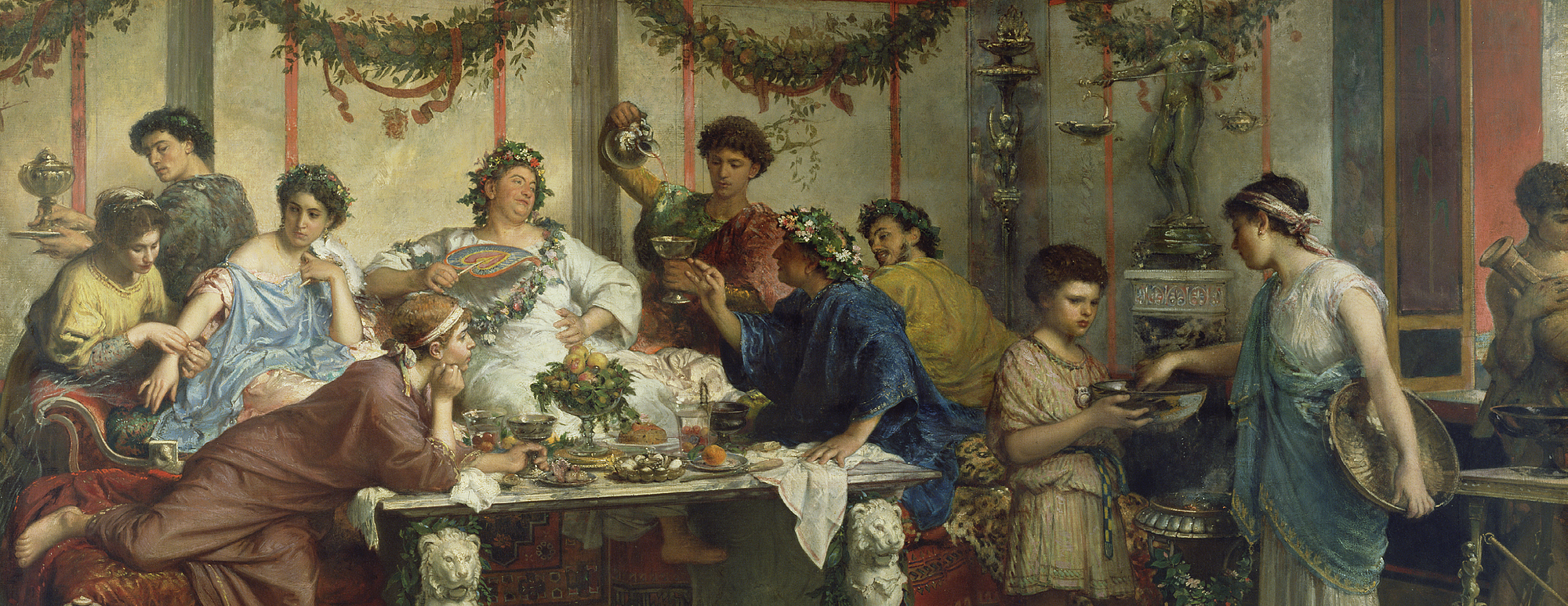
Roberto Bompiani, “A Roman Feast” (c. 1887)
To Make White Wine Out of Red Wine (Vinum ex atro candidum facies)
Put bean meal or three egg-whites into the flask and stir for a very long time. The next day the wine will be white. The white ashes of vine have the same effect
—Apicius 5 (Tr. Flower and Rosebaum)
Such is the kind of “recipe” that one finds in the Roman cookbook attributed to Apicius. So when world-renowned chef Grant Achatz announced that the 2017 menu for his restaurant Next would include “Ancient Rome” — inspired by executive chef Jenner Tomaska’s presenting him with a copy of Apicius — foodies were naturally intrigued. Although translations have been adapted for use for amateur chefs, it’s difficult to imagine what a progressive restaurant known for molecular gastronomy might do with such source material. Next had already garnered rave reviews at their opening in 2011 with their first foray into historical cooking, “Paris 1906,” so it seemed critical for any good classicist worth their salt (insert salary joke here) to get there and roll the proverbial dice.
Would the restaurant tap into the over-the-top decadence we associate with a Roman banquet? Grapes fed by toga-clad waiters, perhaps? Or, as per Life of Brian: lark’s tongues, jaguar’s earlobes, wolf’s nipple chips? The most familiar literary source of such a Roman meal, the Cena Trimalchionis in Petronius’Satyricon doesn’t quite whet the appetite. Trimalchio’s clumsy, over-the-top nonsense does not provide a clear idea of what might be served at a decent table where one might actually want to dine. The promotional video that Achatz posted suggested we might be getting some sword-and-sandal type fun, but said little about what we would actually eat.
When we parted the black veil to access the restaurant’s tiny foyer, we were greeted by a bust of Augustus, reminiscent of the kitsch of Caesar’s Palace in Vegas. But only tasteful touches followed: the table was set with a clay pitcher of enigmatic liquid, a small working Roman oil lamp, a theatrically-aged copy of The Roman Cookery Book (a translation of Apicius by Barbara Flower and Elizabeth Rosenbaum) and a printed menu card. Each menu item was keyed to the recipe in Apicius, which made Classicists familiar with numerical references to, say, comic fragments, feel right at home. The menu’s descriptions consisted of a short reference to an Apicius dish in Latin followed by a corresponding list of ingredients in English used in the modern adaptation (e.g., “cuminatum in ostrea et conchylia ([Apicius] 30) // kamut pancake, oyster, pomengranate”). We were therefore immediately able to consult our text of Apicius for the fuller information on our first dish, vinum ex atro candidum facies, cited above.
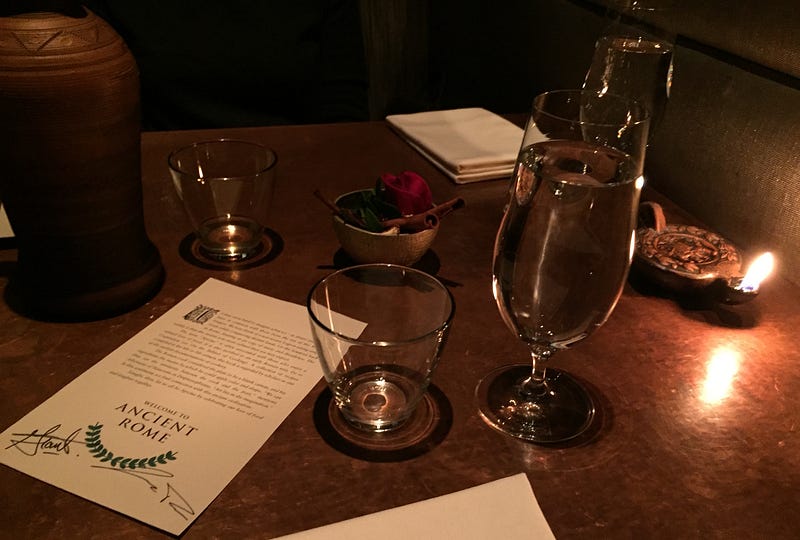 A Roman mensa. All photos by Laura Gawlinski
A Roman mensa. All photos by Laura Gawlinski
Served as a mead-based savory cocktail, it set the dramatic stage for the rest of the evening and exemplified the methodology behind the modernization of the ancient recipes. This drink went through a series of colorful chemical changes as various ingredients like egg whites were added, all while the server provided a brief introduction to alchemy’s relationship to antiquity and bartending: “Don’t watch me, watch the vessel,” she warned, as she performed her magic. It immediately brought to mind the visual tricks of Roman dining, such as is found in the Lycurgus Cup, a large, glass drinking vessel of the 4th century CE now in the possession of the British Museum. The glasswork changes color from red to green depending on the direction of the light shining through it. The drink itself was unusual, the key ingredient oddly being cabbage juice — Cato would have definitely been a fan, even if not everyone at our table was.
All told, we had eighteen separate dishes, several appearing with some overlap, paired with eight different wines (all from locales familiar to the ancient Romans). Each course arrived with an artistic flourish and an explanation via a local server (standing in for the amiable dinner companions of Petronius’ Encolpius). The food was very, very good — even decadent at parts — but the spectacle, by Jove, the spectacle!
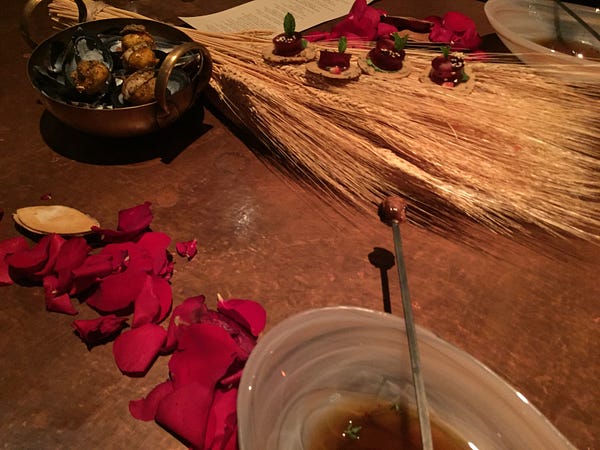 clockwise from left: mussels, kamut pancake served on wheat sheaf, meat sword with broth, patina among rose petals
clockwise from left: mussels, kamut pancake served on wheat sheaf, meat sword with broth, patina among rose petals
The fifth course, patinam de rosis (“a patina from roses”) had the most Petronian flourish. There are many different recipes in Apicius for something called a patina; it seems to have been a frittata or quiche of sorts, a mix of ingredients baked all together. In our case, a mix of mashed asparagus flavored with rosemary had been molded into a rough leaf shape. Although it might appear to be no more than a delicious cracker, an unusual floral ingredient transformed it into an experience. A server arrived bearing glass jars filled with rose petals. With a flourish, she spread the contents out in a line in front of each diner: resting softly amongst the petals were two bites of patina. Perhaps Trimalchio would have done something far more crass, but even he would have applauded this spectacle.
This was followed by what was one of the tastiest dishes in the feast, although it was only a mere bite or two. Aliter tubera: elixas et aspero sale (“another method of truffles: boiled and sprinkled with salt”) was served alongside gustum de betacios et pullus (“a taste of beetroot and chicken”). The black truffle part of this course (tubera) was wrapped with a piece of chicken skin and served on the end of a small metal sword. This came to us balanced over an opaque white bowl into which was poured the gustum, a broth heavily flavored with roasted beets and honey. We swirled the chicken piece in the broth before eating, and then slurped the flavored broth afterward, directly from the bowl.
Presentation continued to matched taste. The next dish, pisam coques (“cooked peas”), was conceptualized as a visual and culinary representation of the ocean. On a spread of whipped mascarpone cheese (representing the sea foam) lay a small piece of mackerel topped with a bit of caviar. Cresting above it, representing the waves, was a fried piece of enoki mushroom. It was light, salty, and not too fishy, a postmodern deconstructed bagel with cream cheese and lox (hold the bagel). Luckily, at this point the pretense of Roman forklessness was dropped, and we were able to enjoy this ocean without making a mess. The cutlery also served to mark the shift from appetizers to main courses and a progression to heavier and meatier foods: fish, then bird, then various meats.
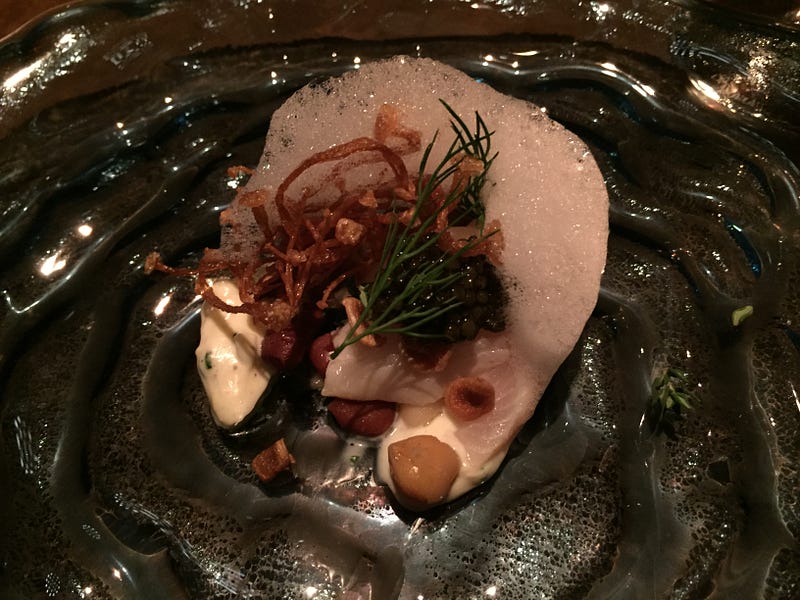 Oceanic wavy blue glass plate and whipped mascarpone
Oceanic wavy blue glass plate and whipped mascarpone
At this point we began to confront our expectations more directly. The briny taste of the “ocean” course highlighted the fact that we had not seen, heard about, or tasted garum, the fish sauce ubiquitous in Roman cooking, or its counterpart, liquamen. Liquamen was regularly listed among the ingredients in Apicius’ version of any given recipe, but we could not tell whether it was included in any of the re-imaginings. However, in cooking with anchovies—a key ingredient for making modern garum—modern chefs can discover much hidden flavor to a dish, so perhaps it was indeed everywhere, just not announced.
We were also surprised by the lack of pork. Pork was so significant to the meat portion of the Roman diet that pork consumption can be linked archaeologically with Roman identity. Larger group tables at Next were able to pay more for the option of a suckling pig: in this case, it was reserved for the highest class and we, dining as mere plebians, were not permitted parity of porkiness.
Furthermore, while we were pleased with the unimposing decor devoid of cheesiness, the minimalist, grey-walled room did not quite fit with the rest of the Roman experience. The non-obtrusive scenery functioned to turn the diners’ focus exclusively onto the food at the table — which made this food, along with its plating and cutlery, the sole decorative art and conversational centerpiece. There would be no distractions from the mosaic plates, salads on monocles, or gold-plated crustaceans. Achatz had curated these accouterments like a Roman emperor, flitting through the provinces gathering a variety of marbles. For the ancients, however, not only was the tableware for show, but the whole space. An extreme example comes from Tiberius’ villa at Sperlonga where a large cave was outfitted for outdoor dining. The decoration included multiple over-life-size sculptural groups — including, most appropriately for a cave, Odysseus preparing to blind the cyclops Polyphemus. None of these diversions at the palace of Achatz.
Our next course provides the perfect example of how the food itself made the setting. The servers brought out a large stone dish filled with smoldering pieces of wood, setting it on a raw chunk of slate. As it was set down, a lump of raw dough coated with poppy seeds, tied up in a piece of cord, was brought along and dropped in the middle of the dish. This, we were told, was a personalized miniature oven and the bread would be baked by what our server dubbed — with all the self-consciousness of a good Plautine servus callidus sharing a witticism — charmelization, the cooking of the dough over the charred wood. The server also informed us that this was how Roman soldiers took their bread on-the-go, but for us, the real Romanitas was in the active participation in the process and the performative presentation.
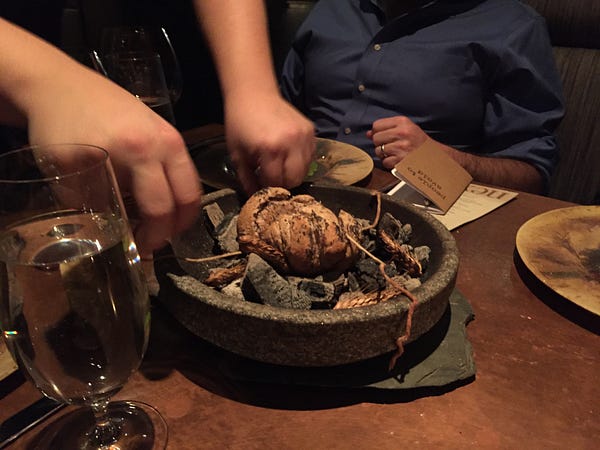 The segmenting of the bread
The segmenting of the bread
The platter was then covered again with the lid, and we moved on to other courses while smelling the baking bread. The suspense, as we wondered what would appear once the lid was removed, added its own spice to the next few courses. When the oven was finally opened, the bread was revealed, beautifully baked. By pulling on the string tying it together, the bread magically collapsed into quarters. Our server explained that because the Romans did not use butter, he would top our bread with a liquified beef fat. This bread, for sure, was both panem and circusem.
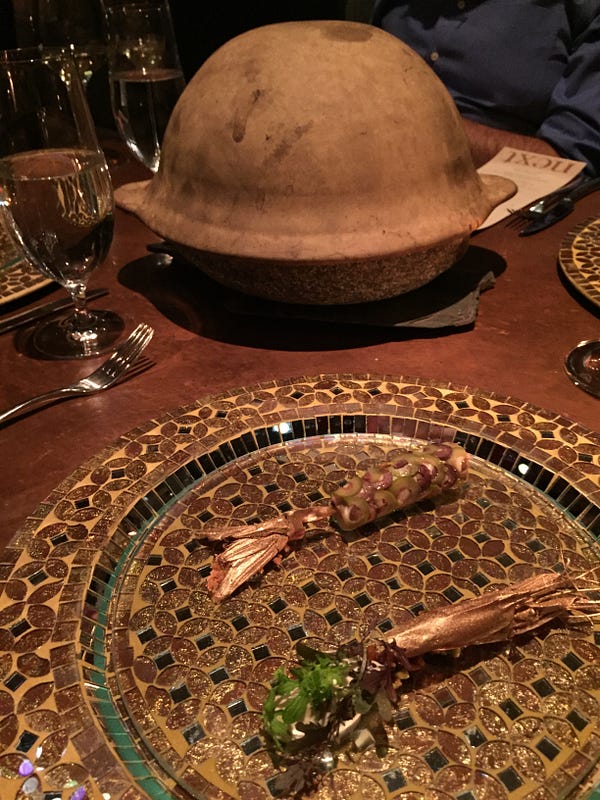 Prawns of gold and olive, bread baking in background
Prawns of gold and olive, bread baking in background
One of the dishes theatrically served as we waited for the bread was the maritime isicia de scillis vel de cammaris amplis (“Rissoles of squid or large prawn”). What we actually ate was a prawn, but it was surrounded by an armored suit of sliced olives — shockingly the only recognizable appearance of olives throughout the evening. The real prawn shell had been removed whole and put to the side, decadently painted with real gold.
Our final meat dish contained the most impressive display of the mains. The food itself was oxtail, based on sales conditos ad multa (“aromatic salt used for many purposes”), but the visual focus was the salt of the title. The oxtail was served pot-roast style in a small glass bowl mixed with pieces of turnip and some fried pieces of horseradish for extra flavor. This glass bowl rested in the middle of a much larger copper bowl richly filled with aromatic salt (salt with cloves, anise seeds and other spices). Lining the back of the bowl were smoldering cinnamon sticks, driven into the salt like stakes protecting the Greek navy positioned in the sand of Troy. Between the smell of the spices and the tactile pleasure of the salt (no one could keep themselves from running their fingers through it), we were reminded how much a good meal appeals to all the senses.

To Make White Wine Out of Red Wine (Vinum ex atro candidum facies)
Put bean meal or three egg-whites into the flask and stir for a very long time. The next day the wine will be white. The white ashes of vine have the same effect
—Apicius 5 (Tr. Flower and Rosebaum)
Such is the kind of “recipe” that one finds in the Roman cookbook attributed to Apicius. So when world-renowned chef Grant Achatz announced that the 2017 menu for his restaurant Next would include “Ancient Rome” — inspired by executive chef Jenner Tomaska’s presenting him with a copy of Apicius — foodies were naturally intrigued. Although translations have been adapted for use for amateur chefs, it’s difficult to imagine what a progressive restaurant known for molecular gastronomy might do with such source material. Next had already garnered rave reviews at their opening in 2011 with their first foray into historical cooking, “Paris 1906,” so it seemed critical for any good classicist worth their salt (insert salary joke here) to get there and roll the proverbial dice.
Would the restaurant tap into the over-the-top decadence we associate with a Roman banquet? Grapes fed by toga-clad waiters, perhaps? Or, as per Life of Brian: lark’s tongues, jaguar’s earlobes, wolf’s nipple chips? The most familiar literary source of such a Roman meal, the Cena Trimalchionis in Petronius’Satyricon doesn’t quite whet the appetite. Trimalchio’s clumsy, over-the-top nonsense does not provide a clear idea of what might be served at a decent table where one might actually want to dine. The promotional video that Achatz posted suggested we might be getting some sword-and-sandal type fun, but said little about what we would actually eat.
When we parted the black veil to access the restaurant’s tiny foyer, we were greeted by a bust of Augustus, reminiscent of the kitsch of Caesar’s Palace in Vegas. But only tasteful touches followed: the table was set with a clay pitcher of enigmatic liquid, a small working Roman oil lamp, a theatrically-aged copy of The Roman Cookery Book (a translation of Apicius by Barbara Flower and Elizabeth Rosenbaum) and a printed menu card. Each menu item was keyed to the recipe in Apicius, which made Classicists familiar with numerical references to, say, comic fragments, feel right at home. The menu’s descriptions consisted of a short reference to an Apicius dish in Latin followed by a corresponding list of ingredients in English used in the modern adaptation (e.g., “cuminatum in ostrea et conchylia ([Apicius] 30) // kamut pancake, oyster, pomengranate”). We were therefore immediately able to consult our text of Apicius for the fuller information on our first dish, vinum ex atro candidum facies, cited above.
 A Roman mensa. All photos by Laura Gawlinski
A Roman mensa. All photos by Laura GawlinskiServed as a mead-based savory cocktail, it set the dramatic stage for the rest of the evening and exemplified the methodology behind the modernization of the ancient recipes. This drink went through a series of colorful chemical changes as various ingredients like egg whites were added, all while the server provided a brief introduction to alchemy’s relationship to antiquity and bartending: “Don’t watch me, watch the vessel,” she warned, as she performed her magic. It immediately brought to mind the visual tricks of Roman dining, such as is found in the Lycurgus Cup, a large, glass drinking vessel of the 4th century CE now in the possession of the British Museum. The glasswork changes color from red to green depending on the direction of the light shining through it. The drink itself was unusual, the key ingredient oddly being cabbage juice — Cato would have definitely been a fan, even if not everyone at our table was.
All told, we had eighteen separate dishes, several appearing with some overlap, paired with eight different wines (all from locales familiar to the ancient Romans). Each course arrived with an artistic flourish and an explanation via a local server (standing in for the amiable dinner companions of Petronius’ Encolpius). The food was very, very good — even decadent at parts — but the spectacle, by Jove, the spectacle!
 clockwise from left: mussels, kamut pancake served on wheat sheaf, meat sword with broth, patina among rose petals
clockwise from left: mussels, kamut pancake served on wheat sheaf, meat sword with broth, patina among rose petalsThe fifth course, patinam de rosis (“a patina from roses”) had the most Petronian flourish. There are many different recipes in Apicius for something called a patina; it seems to have been a frittata or quiche of sorts, a mix of ingredients baked all together. In our case, a mix of mashed asparagus flavored with rosemary had been molded into a rough leaf shape. Although it might appear to be no more than a delicious cracker, an unusual floral ingredient transformed it into an experience. A server arrived bearing glass jars filled with rose petals. With a flourish, she spread the contents out in a line in front of each diner: resting softly amongst the petals were two bites of patina. Perhaps Trimalchio would have done something far more crass, but even he would have applauded this spectacle.
This was followed by what was one of the tastiest dishes in the feast, although it was only a mere bite or two. Aliter tubera: elixas et aspero sale (“another method of truffles: boiled and sprinkled with salt”) was served alongside gustum de betacios et pullus (“a taste of beetroot and chicken”). The black truffle part of this course (tubera) was wrapped with a piece of chicken skin and served on the end of a small metal sword. This came to us balanced over an opaque white bowl into which was poured the gustum, a broth heavily flavored with roasted beets and honey. We swirled the chicken piece in the broth before eating, and then slurped the flavored broth afterward, directly from the bowl.
Presentation continued to matched taste. The next dish, pisam coques (“cooked peas”), was conceptualized as a visual and culinary representation of the ocean. On a spread of whipped mascarpone cheese (representing the sea foam) lay a small piece of mackerel topped with a bit of caviar. Cresting above it, representing the waves, was a fried piece of enoki mushroom. It was light, salty, and not too fishy, a postmodern deconstructed bagel with cream cheese and lox (hold the bagel). Luckily, at this point the pretense of Roman forklessness was dropped, and we were able to enjoy this ocean without making a mess. The cutlery also served to mark the shift from appetizers to main courses and a progression to heavier and meatier foods: fish, then bird, then various meats.
 Oceanic wavy blue glass plate and whipped mascarpone
Oceanic wavy blue glass plate and whipped mascarponeAt this point we began to confront our expectations more directly. The briny taste of the “ocean” course highlighted the fact that we had not seen, heard about, or tasted garum, the fish sauce ubiquitous in Roman cooking, or its counterpart, liquamen. Liquamen was regularly listed among the ingredients in Apicius’ version of any given recipe, but we could not tell whether it was included in any of the re-imaginings. However, in cooking with anchovies—a key ingredient for making modern garum—modern chefs can discover much hidden flavor to a dish, so perhaps it was indeed everywhere, just not announced.
We were also surprised by the lack of pork. Pork was so significant to the meat portion of the Roman diet that pork consumption can be linked archaeologically with Roman identity. Larger group tables at Next were able to pay more for the option of a suckling pig: in this case, it was reserved for the highest class and we, dining as mere plebians, were not permitted parity of porkiness.
Furthermore, while we were pleased with the unimposing decor devoid of cheesiness, the minimalist, grey-walled room did not quite fit with the rest of the Roman experience. The non-obtrusive scenery functioned to turn the diners’ focus exclusively onto the food at the table — which made this food, along with its plating and cutlery, the sole decorative art and conversational centerpiece. There would be no distractions from the mosaic plates, salads on monocles, or gold-plated crustaceans. Achatz had curated these accouterments like a Roman emperor, flitting through the provinces gathering a variety of marbles. For the ancients, however, not only was the tableware for show, but the whole space. An extreme example comes from Tiberius’ villa at Sperlonga where a large cave was outfitted for outdoor dining. The decoration included multiple over-life-size sculptural groups — including, most appropriately for a cave, Odysseus preparing to blind the cyclops Polyphemus. None of these diversions at the palace of Achatz.
Our next course provides the perfect example of how the food itself made the setting. The servers brought out a large stone dish filled with smoldering pieces of wood, setting it on a raw chunk of slate. As it was set down, a lump of raw dough coated with poppy seeds, tied up in a piece of cord, was brought along and dropped in the middle of the dish. This, we were told, was a personalized miniature oven and the bread would be baked by what our server dubbed — with all the self-consciousness of a good Plautine servus callidus sharing a witticism — charmelization, the cooking of the dough over the charred wood. The server also informed us that this was how Roman soldiers took their bread on-the-go, but for us, the real Romanitas was in the active participation in the process and the performative presentation.
 The segmenting of the bread
The segmenting of the breadThe platter was then covered again with the lid, and we moved on to other courses while smelling the baking bread. The suspense, as we wondered what would appear once the lid was removed, added its own spice to the next few courses. When the oven was finally opened, the bread was revealed, beautifully baked. By pulling on the string tying it together, the bread magically collapsed into quarters. Our server explained that because the Romans did not use butter, he would top our bread with a liquified beef fat. This bread, for sure, was both panem and circusem.
 Prawns of gold and olive, bread baking in background
Prawns of gold and olive, bread baking in backgroundOne of the dishes theatrically served as we waited for the bread was the maritime isicia de scillis vel de cammaris amplis (“Rissoles of squid or large prawn”). What we actually ate was a prawn, but it was surrounded by an armored suit of sliced olives — shockingly the only recognizable appearance of olives throughout the evening. The real prawn shell had been removed whole and put to the side, decadently painted with real gold.
Our final meat dish contained the most impressive display of the mains. The food itself was oxtail, based on sales conditos ad multa (“aromatic salt used for many purposes”), but the visual focus was the salt of the title. The oxtail was served pot-roast style in a small glass bowl mixed with pieces of turnip and some fried pieces of horseradish for extra flavor. This glass bowl rested in the middle of a much larger copper bowl richly filled with aromatic salt (salt with cloves, anise seeds and other spices). Lining the back of the bowl were smoldering cinnamon sticks, driven into the salt like stakes protecting the Greek navy positioned in the sand of Troy. Between the smell of the spices and the tactile pleasure of the salt (no one could keep themselves from running their fingers through it), we were reminded how much a good meal appeals to all the senses.

sales conditos ad multa
The final dishes were desserts, accompanied by a last, very sweet wine from the Canary Islands. The penultimate course, gustum de praecoquis (“stew of apricots”), we now remember very fuzzily, as an Aristodemus-like haze from the wine and food had set in (our notes from the evening at this point merely say, “Where’s my cheesecake?”). The meal then satisfied the saying, ab ovo usque ad mala: having begun with an egg, emulsified into the magical first drink, it ended with an apple. Not quite an apple, though: that “apple” in the final, towering fruit basket was but a final illusion. Pulling out slices we found not fruit but a delightful candy-shelled ice cream. Alongside it, a final, memorable taste, donum felix (“happy gift”), a piece of taffy fittingly made of mastic, the tree sap that comes from the island of Chios, birthplace of Homer.
When asked about the historically-based Paris menu in the NY Times, Achatz had mused that it’s better for a good restaurant to choose the replication of a philosophy over the replication of a recipe. His Roman meal at Next might not have been exactly what Apicius had in mind, but the philosophy and aesthetic were solidly Roman. Thumbs up!
The final dishes were desserts, accompanied by a last, very sweet wine from the Canary Islands. The penultimate course, gustum de praecoquis (“stew of apricots”), we now remember very fuzzily, as an Aristodemus-like haze from the wine and food had set in (our notes from the evening at this point merely say, “Where’s my cheesecake?”). The meal then satisfied the saying, ab ovo usque ad mala: having begun with an egg, emulsified into the magical first drink, it ended with an apple. Not quite an apple, though: that “apple” in the final, towering fruit basket was but a final illusion. Pulling out slices we found not fruit but a delightful candy-shelled ice cream. Alongside it, a final, memorable taste, donum felix (“happy gift”), a piece of taffy fittingly made of mastic, the tree sap that comes from the island of Chios, birthplace of Homer.
When asked about the historically-based Paris menu in the NY Times, Achatz had mused that it’s better for a good restaurant to choose the replication of a philosophy over the replication of a recipe. His Roman meal at Next might not have been exactly what Apicius had in mind, but the philosophy and aesthetic were solidly Roman. Thumbs up!
No comments:
Post a Comment